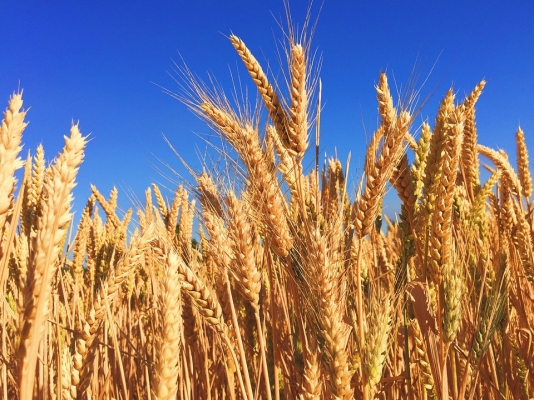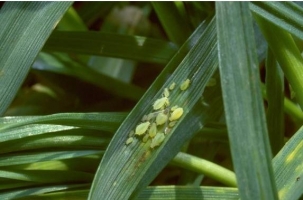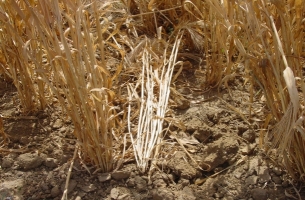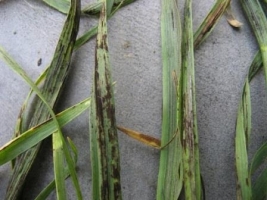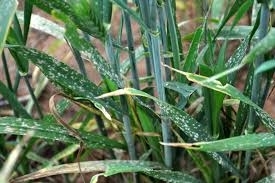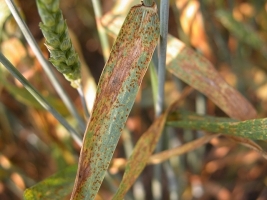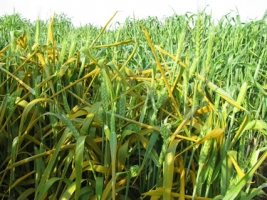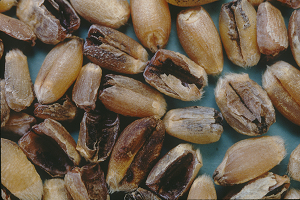PBW 752: Late variety. This variety is suitable for sowing in irrigated conditions. It gives an average yield of 19.2qtl/acre.
PBW 1 Zn: The plant of this variety attains the height of 103 cm. the crop is ready to harvest in 151 days. It gives an average of 22.5 qtl/acre of crop yield.
UNNAT PBW 343: Suitable for irrigated and timely sown areas. Ready to harvest in 155 days. It is resistant to lodging, water logging conditions. It is also resistant to karnal bunt and tolerant to blight. It gives average yield of 23.2 qtl/acre.
WH 542: It is suitable for timely sown, irrigated areas. Ready to harvest in 135-145 days. It is resistant to stripe rust, leaf rust and karnal bunt. It give average yield of 20 qtl/acre.
PBW 725: It is dwarf variety, released by Punjab Agriculture University. It is suitable for timely sown irrigated areas. It is resistant to yellow and brown rust. Its grains are amber, hard and medium bold. It is ready to harvest in 155 days. It gives average yield of 23 qtl/acre.
PBW 677 (2015): It is moderately resistant to yellow and brown rust. Its average grain yield is 22.4 quintals per acre. This variety is suitable for growing under poplar plantation.
HD 2851: This variety is suitable for timely sowing and is grown in irrigated areas. The variety matures in 126-134 days and the plant attains the height of 80-90cm.
WHD-912: It is a double dwarf Durum variety which is used for Bakery in Industry. Protein content 12%. Resistant Yellow & Brown and rust as well as karnal bunt. The yield is near about 21 qtl/ acre.
HD 3043: Gives average yield of 17.8 qtl/acre. It has shown a high level of resistance against stripe rusts and leaf rust. It has the higher value of bread loaf volume (cc), bread quality score."
WH 1105: Developed by Punjab Agriculture University. It is a double dwarf variety with an average plant height of 97 cm. Its grains are amber, hard, medium bold and lustrous. It is resistant to yellow rust and brown rust but susceptible to karnal bunt and loose smut diseases. It matures in about 157 days and its average grain yield is 23.1 quintals per acre.
PBW 660: Developed by Punjab Agriculture University released for cultivation under rain fed conditions in the Punjab state. It is a dwarf variety with an average plant height of 100 cm. Its grains are amber, hard, bold and lustrous with very good chapatti quality. It is resistant to yellow and brown rusts but susceptible to lose smut disease. It matures in about 162 days and its average grain yield is 17.1 quintals per acre.
PBW-502: Developed by Punjab Agricultural University. Suitable for timely sown irrigated conditions. It is resistant to leaf rust and stripe rust. Average yield 20.4 quintal per acre.
HD 3086(PusaGautam): It gives average yield of 23 qtl/acre. It is resistant to yellow rust and brown rust. It meets all the criteria for superior bread making qualities.
HD 2967: It is double dwarf variety with an average plant height of 101 cm. The ears are medium dense. It is resistant to yellow and brown rust but susceptible to karnal bunt and loose smut diseases. It takes about 157 days to mature. The yield is 21.5 qtl/acre.
DBW17: The height of the plant is 95 cm. Grains are amber hard, medium bold and lustrous. It is susceptible to new races of yellow rust and moderately resistant to brown rust. It matures in 155 days. The average yield is 23 qtl/acre.
PBW 621: It is grown in all areas of Punjab. It gets ready for harvesting within 158 days. It is resistant to yellow and brown rusts diseases. It has an average height of 100cm. Its average yield is about 21.1 quintal per acre.
UNNAT PBW 550: It is grown in all areas of Punjab. It gets ready for harvesting within 145 days. It is resistant to yellow and brown rusts diseases. It has an average height of 86 cm. It gives an average yield of 23 qtl/acre.
TL 2908: It is grown in all areas of Punjab. It gets ready for harvesting within 153 days. It is resistant to mostly all major diseases. It has an average height of 113 cm.
PBW 175: It is grown in all areas of Punjab. It gets ready for harvesting within 165 days. It is resistant to Rust and Karnal bunt diseases. It has an average height of 110 cm. It gives average yield of 17.8 quintals per acre.
PBW 527: It is grown in all areas of Punjab. It gets ready for harvesting within 160 days. It is resistant to yellow and brown rust diseases. It has an average height of 100 cm.
WHD 943: It is grown in all areas of Punjab. It gets ready for harvesting within 154 days. It is resistant to yellow and brown rust diseases. It has an average height of 93 cm.
PDW 291: It is grown in all areas of Punjab. It gets ready for harvesting within 155 days. It is resistant to yellow and brown rust, loose smut and flag smut diseases. It has an average height of 83 cm.
PDW 233: It is grown in all areas of Punjab. It gets ready for harvesting within 150 days. It is resistant to yellow and brown rust, loose smut and karnal bunt diseases. It has an average height of 98 cm. It gives an average yield of 19.5 quintals per acre.
PBW 590: It is grown in all areas of Punjab. It gets ready for harvesting within 128 days. It is resistant to yellow and brown rusts diseases. It has an average height of 80cm.
PBW 509: It is grown in all areas of Punjab except sub-mountainous region. It gets ready for harvesting within 130 days. It is resistant to yellow and brown rusts diseases. It has an average height of 85cm.
PBW 373: It is grown in all areas of Punjab. It gets ready for harvesting within 140 days. It is resistant to brown rusts diseases. It has an average height of 90 cm. It gives average yield of 16.4 quintals per acre.
PBW 869 (2021): It is recommended for sowing with happy seeder / super seeder and PAU smart seeder in in-situ rice residue managed fields and account with seed rate of 45 kg per acre. Resistant to brown rust and moderately resistant to yellow rust. Its average yield is about 23.2 quintal per acre.
PBW 824 (2021): This variety is mature in 156 days. It is resistant to yellow rust and moderately resistant to yellow rust. Its average yield is about 23.3quintal per acre.
PBW 803 (2021): It is recommended for the cultivation in south-western region of Punjab (Bathinda, Faridkot, Shri muktsar sahib, mansa and Ferozepur). It is resistant to brown rust and moderately resistant to yellow rust. It is average yield is about 23.7 quintal per acre.
Sunehri (PBW 766) (2020): This variety is resistant to brown rust and moderately resistant to yellow rust. Its average yield is about 23.1 quintal per acre.
HD 3271 (2020): It is suitable for late sown conditions. It is resistant to stripe rust, and leaf rust. It matures in about 104 days and Its average yield is about 13.1 quintals per acre.
HD 3298 (2020): It is suitable for late sown conditions. It is resistant to yellow rust, leaf rust and brown rust. It matures in about 104 days and Its average yield is about 15.6 quintals per acre.
HI 1628 (2020): It is tolerant variety to terminal heat. It matures in about 147 days and Its average yield is about 20.1 quintals per acre.
PBW 1 chapati (2020): It is a premium quality bread wheat variety having excellent chapati making properties. It is resistant to brown rust and moderately resistant to yellow rust. Its average yield is about 17.2 quintal per acre.
DBW 222 (2020): It is recommended for cultivation of wheat except sub-mountainous regions. Moderately susceptible to yellow rust and resistant to brown rust. Its average yield is about 22.3 quintal per acre.
DBW 187 (2020): It is resistant to brown rust and moderately resistant to yellow rust. Its average yield is about 22.6 quintal per acre.
HD 3226 (2020): It is resistant to yellow and brown rust. It possesses good grain quality characteristics and its average yield 21.9 q per acre.
HD 3237 (2019): It is suitable variety for bread and chapati making. It is resistant to yellow rust, leaf rust and brown rust. It matures in about 145 days and Its average yield is about 19.36 quintals per acre.
HI 1620 (2019): It is suitable for sown under drought conditions and terminal heat. It is resistant to yellow rust, leaf rust and brown rust. It matures in about 146 days and Its average yield is about 19.6 quintals per acre.
HI 1621 (2019): It is suitable for late sown conditions. It is resistant to yellow rust, leaf rust and brown rust. It matures in about 102 days and Its average yield is about 13.1 quintals per acre.
UNNAT PBW 343 (2017): It is suitable for irrigated and timely sown areas. Ready to harvest in 155 days. It is resistant to lodging, water logging conditions. It is also resistant to Karnal bunt and tolerant to blight. It gives average yield of 23.2 quintals per acre.
PBW 677 (2015): It is moderately resistant to yellow and brown rust. Its average grain yield is 22.4 quintals per acre. This variety is suitable for growing under poplar plantation.
HD 3059 (2014): It is late sown variety and mature in about 121 days. It is suitable variety for bread and chapati. It is resistant to all type of rust. It gives average yield of 17.4 qtl/acre.
PBW 660 (2014): Developed by Punjab Agriculture University released for cultivation under rain fed conditions in the Punjab state. It is a dwarf variety with an average plant height of 100 cm. Its grains are amber, hard, bold and lustrous with very good chapatti quality. It is resistant to yellow and brown rusts but susceptible to lose smut disease. It matures in about 162 days and its average grain yield is 17.1 quintals per acre.
HD 2967 (2011): It is double dwarf variety with an average plant height of 101 cm. The ears are medium dense. It is resistant to yellow and brown rust but susceptible to Karnal bunt and loose smut diseases. It takes about 157 days to mature. The yield is 21.5 quintals per acre.
Late sown irrigated varieties
PBW 771 (2020): It is moderately resistant to yellow rust and resistant to brown rust. Average yield 19.0 quintals per acre.
PBW 757 (2020): It is sown under late and irrigated conditions (January sowing). Average yield 15.8 quintals per acre. It is moderately resistant to yellow rust and resistant to brown rust.
PBW 752 (2019): It is resistant to yellow and brown rust. Its average plant height is 89 cm and matures in about 130 days. Its average grain yield is 19.2 quintals per acre.
OTHER STATE VARIETIES:-
RAJ-3765: It matures in 120-125 days. Heat tolerant and suitable for zero tillage, Susceptible to brown rust, moderately susceptible to stripe rust and karnal bunt. The yield is near about 21 qtl/ acre.
UP-2338: It matures in 125-130 days. It is susceptible to leaf rust and moderately susceptible to stripe rust. Susceptible to karnal bunt and tolerant to blight. The yield is near about 21 qtl/acre.
UP-2328: It matures in 130-135 days. Ear heads are hard, sarbati colour & medium size grains. It is suitable for irrigated areas. The yield is near about 20-22 qtl/acre.
Sonalika: Early maturing single dwarf wheat with wide adaptation and attractive amber grains. It is suitable for late sowing and resistant to rusts. The yield is near about 13.8 quintals per acre.
Kalyansona: A double dwarf wheat with wide adaptation recommended for cultivation all over India. This variety is very vulnerable to rust. It is, therefore, advisable to grow it only in rust free regions. It gives average yield of 12.4 quintals per acre.
UP-(368): High yielding variety developed by Pantnagar. It is resistant to rust and karnal bunt.
WL-(711): It is single dwarf, high yielding and medium maturing variety. It is moderately susceptible to powdery mildew and karnal bunt. It gives average yield of 18.1 quintals per acre.
UP-(319): It is triple dwarf wheat with high level of rust resistance. To avoid losses to shattering, it should be harvested at appropriate time. It gives average yield of 13.4 quintals per acre.
HD3249: This variety is timely sown under irrigated conditions. Its average yield is about 19.4 quintals per acre. It is resistant to yellow rust, leaf rust and brown rust.
Late varieties of wheat - HD-2932, RAJ-3765, PBW-373, UP-2338, WH-306, 1025.

